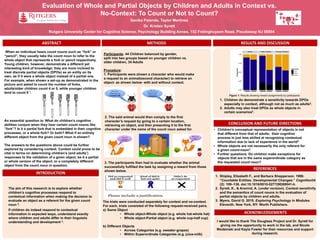
Approved ISR Poster Spring 2020
- 1. Evaluation of Whole and Partial Objects by Children and Adults in Context vs. No-Context: To Count or Not to Count? Sanika Palande, Taylor Martinez Dr. Kristen Syrett When an individual hears count nouns such as “fork” or “pencil”, they usually take the count noun to refer to the whole object that represents a fork or pencil respectively. Young children, however, demonstrate a different yet interesting kind of knowledge; they are more inclined to treat discrete partial objects (DPOs) as an entity on its own, as if it were a whole object instead of a partial one. For example, when shown a set-up as demonstrated in the picture and asked to count the number of forks, adults/older children count 4 or 5, while younger children tend to count 6 1. INTRODUCTION ABSTRACT RESULTS AND DISCUSSIONMETHODS CONCLUSION AND FUTURE DIRECTIONS ACKNOWLEDGEMENTS REFERENCES I would like to thank The Douglass Project and Dr. Syrett for giving me the opportunity to work in the lab, and Nicole Wodzinski and Kayla Fowler for their resources and support during research. 1. Shipley, Elizabeth F., and Barbara Shepperson. 1990. “Countable Entities: Developmental Changes.” Cognition34 (2): 109–136. doi:10.1016/0010-0277(90)90041-h. 2. Syrett, K., & Aravind, A. (under revision). Context sensitivity and the semantics of count nouns in the evaluation of partial objects by children and adults. 3. Myers, David G. 2019. Exploring Psychology in Modules. Eleventh. New York, NY: Worth Publishers. The aim of this research is to explore whether children’s cognitive processes respond to contextual information when making the decision to evaluate an object as a referent for the given count noun 2. If children do indeed respond to contextual information in expected ways, understand exactly where children and adults differ in their linguistic understanding and development 2. An essential question is: What do children’s cognitive abilities conjure when they hear certain count nouns like ”fork”? Is it a partial fork that is embedded in their cognitive processes, or a whole fork? Or both? What if an entirely different object from the given count noun is shown? The answers to the questions above could be further explored by considering context. Context could prove to be vital in terms on determining children’s (and adults’) responses to the validation of a given object, be it a partial or whole version of the object, or a completely different object from the count noun in question. • Children’s conceptual representation of objects is not that different from that of adults; their cognitive process is just less skilled at recognizing contextual information due to lack of experience in the world2. • Whole objects are not necessarily the only referent for a given count-noun2. • Further questions: Do children make exceptions for objects that are in the same superordinate category as the requested count noun? Participants: 44 Children balanced by gender, split into two groups based on younger children vs. older children, 34 Adults Procedure: 1. Participants were shown a character who would make a request to an animal(second character) to retrieve an object- as shown below- with and without context. 2. The said animal would then comply to the first character’s request by going to a certain location, retrieving an object, and then presenting it to the first character under the name of the count noun asked for. 3. The participants then had to evaluate whether the animal successfully fulfilled the task by assigning a reward from those shown below. The trials were conducted separately for context and no-context. For each, trials consisted of the following request-received pairs. a) Same Object • Whole object-Whole object (e.g. whole hat-whole hat) • Whole object-Partial object (e.g. whole cup-half cup) b) Different Objects • Across Categories (e.g. sweater-grapes) • Within Superordinate Categories (e.g. juice-milk) Rutgers University Center for Cognitive Science, Psychology Building Annex, 152 Frelinghuysen Road, Piscataway NJ 08854 Figure 1: Results showing reward assignments by participants 1. Children do demonstrate a sensitivity towards DPOs especially in context, although not as much as adults2. 2. Adults may also treat DPOs as whole objects in certain scenarios2.